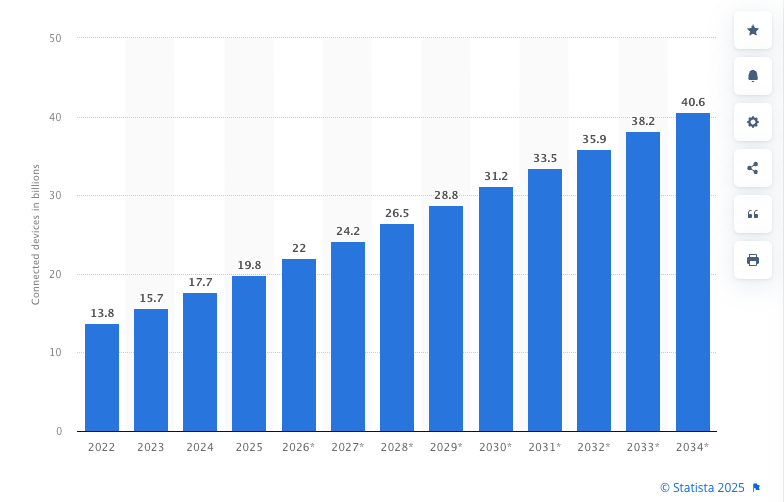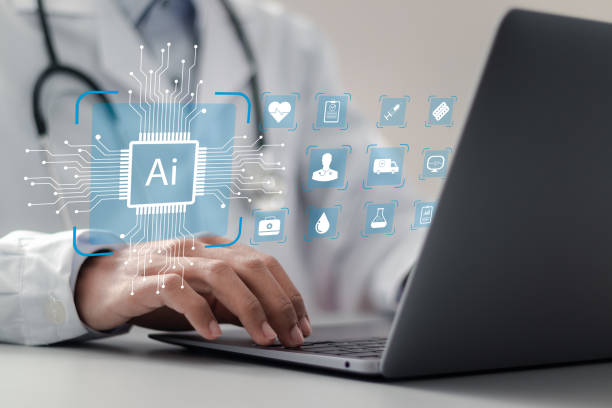Remote Patient Monitoring (RPM) and The Internet of Medical Things (IoMT) are technologies responsible for improving patient outcomes and reducing healthcare costs in chronic conditions such as heart disease and COPD. This article explores IoMT, how it integrates with RPM, and five key benefits of these connected healthcare solutions.
To understand IoMT and RPM, we will first start by introducing and defining the Internet of Things. IoT refers to a network of connected devices that collect and share data. These devices range from home automation tools, such as smart lightbulbs controlled via smartphone apps, to city infrastructure like web-connected streetlights that can be managed remotely.
IoT technology enables real-time data transmission, remote monitoring, and automated control. It includes sensors, software, and internet connectivity that streamlines communication between devices without requiring direct human interaction. Statista reports that of 2025, there are roughly 19.8 billion IoT devices globally. By 2034, the number of IoT connections is expected to reach 40.6 billion.

RPM and IoMT
The Internet of Medical Things is the vast collection of medical devices and applications that connect to healthcare technology systems. IoMT enables RPM, screening, and treatment via telehealth. RPM’s primary goal is focused on providing value-based and real-time healthcare by monitoring patient biometrics.
IoMT and RPM allow patients to transfer biometric data safely, securely, and efficiently. And healthcare providers gain 24-hour access to patient health data. Thus, allowing them to intervene quickly when complications arise, resulting in several healthcare benefits and financial rewards.
IoMT monitors vital signs like blood pressure, heart rate, pulse, and blood glucose levels. Patients take measurements with remote patient monitoring devices, and the readings are automatically transmitted to remote patient monitoring platforms. Below are common RPM devices available to patients and providers.
How Does IoMT Make RPM Work?
This section clarifies how IoMT helps remote patient monitoring work. IoMT supports RPM as it offers a network that connects RPM devices, smartwatches, and wearables to enable real-time sharing of health information between patients and providers. A study published in the Journal of Oral Biology and Craniofacial Research explains that IoMT systems work in main layers.
The layers integrate technologies, devices, sensors, and systems and connects via electronic and wired or wireless connections. Each layer serves a specific purpose in delivering the vital sign data to the physician.
The following section will describe each of the following 4 layers and their function.
- Application layer
- Data storage layer
- Gateway layer
- Perception layer
1) IoMT Perception Layer in RPM
The first layer in IoMT and RPM comprises sources that include smart objects, health monitoring devices, and mobile apps. The sources have sensors that are either infrared, medical or a smart device. First, these sensing systems perceive changes in an environment. Then, they recognize the data source and convert it into digital signals. Finally, the data is transmitted via a wireless network transmission and saved for future reference.
2) IoMT Gateway layer in RPM
Next comes the gateway layer. This layer in IoMT and RPM uses sensors connecting to a health hub or gateway via short-range wireless networks like Bluetooth, low-power Wi-Fi, cellular communications, or long-range networks. Comparatively, long-range networks are cloud computing or cellular networks. These networks are most reliable in simultaneously connecting many remote patient monitoring devices.
The Tenovi Gateway is one example of a leading-edge health hub. It offers the following features.
- Seamlessly connects to a growing list of Tenovi and 3rd party devices.
- Uses the most modern CATM-1 cellular technology.
- Connects to most cellular carriers in the U.S.
- Automatically transmits patient data to HIPAA-compliant Tenovi Cloud through a cellular network.
- Non-obtrusive visual reminders to improve adherence.
- Cybersecurity encryption and authentication.
- Ready for use right out of the box – no syncing or apps are required.
3) IoMT and RPM Management Service Layer
Next, processing raw data and flagging the correct data for users and data management and analysis requires using management layer tools. To clarify, web servers and gateways provide scalability and flexibility and allow data to be stored in a cloud server. For example, this is electronic medical records (EMRs) from patient portals and vital sign data from RPM devices or smartphone apps. Finally, data is stored in the cloud for the physician to review.
4) IoMT Application Service Layer in RPM
Finally, the primary function of the application layer is to interpret the data provided by RPM devices. This layer uses Artificial Intelligence (AI) to understand the RPM data while monitoring trends and changes. Patient data is provided to the physician for review via plots. Healthcare applications for IoMT include predicting risk, managing chronic conditions like diabetes and kidney disease, and predicting the progression of diseases such as congestive heart failure.
Benefits of IoMT in RPM
IoMT enhances RPM by transforming how data is shared, supporting a more convenient and value-based approach to healthcare that benefits patients and clinicians alike.
5 key benefits of IoMT in RPM include:
1) IoMT and RPM Promotes Preventive Care
Additionally, RPM allows clinicians to provide better care between appointments. By closely monitoring how patients are doing outside the clinical setting in everyday life, care providers identify complications early and can focus on preventive treatment.
One prominent feature of RPM and IoMT is the ability of remote patient monitoring platforms to alert clinicians immediately when a patient’s readings exceed set thresholds. Care providers are instantly alerted, allowing them to immediately provide medical attention while the complication is in the early stage. This minimizes the cost of healthcare admissions and reduces emergency room visits.
2) RPM Requires Minimal Effort by the patient
A second benefit of IoMT in RPM is that RPM devices are easy to use, requiring little patient effort. Patients do not often comply with complicated or time-consuming treatment plans. Tenovi remote physiological monitoring devices are easy to use. Remote patient monitoring devices instantly send patient vital sign readings to a remote patient monitoring portal.
When the Tenovi Gateway LED ring light is red, it’s time for the patient to take a measurement. The LED ring turns green once a measurement is sent to the cloud. In addition, clients can set up alert notifications that provide visual and auditory reminders to the patient.
Medicare covers RPM, however, the patient must use the remote patient monitoring device for at least 16 days out of the month. A simple RPM process takes stress off of the patient. Patients do not have to write down information, take pictures or send readings to their provider. Tenovi RPM devices require no pairing with additional software or use of apps and are ready to use right out of the box.
3) RPM Services Securely Stores Patient Data
Another significant benefit is that RPM devices safely and securely collect, transmit and store patient health data. A detailed patient health history develops and grows fast. This gives providers a better understanding of the patient’s condition, enabling better treatment. When RPM devices are FDA-cleared and HIPAA-compliant, it means accurate data is being safely stored, and communication is secure. That is because all data is encrypted in transit and stored to ensure patient privacy. Therefore, patients can rest assured that their health information is safe and secure.
4) RPM and IoMT Keep Providers and Patients Connected
As discussed previously, remote patient monitoring devices use Bluetooth, Wi-Fi, or cellular technologies to transmit data in real-time. Patients who frequently communicate with care teams are more likely to be better engaged in managing their health. This is important since patient engagement is essential in determining health outcomes.
Although the most successful treatment plan does not work if the patient does not follow it, RPM keeps patients actively managing their health. Additionally, physicians can track patient engagement. Patients can communicate with care providers frequently and access the RPM platform whenever they want to check their health status.
5) Wider Access to Healthcare with RPM and IoMT
IoMT enables more comprehensive access to RPM health services. With RPM, the main focus is to improve the efficiency of the healthcare experience for both patients and clinicians. In addition, IoMT’s secure and fast data transmission minimizes the need for travel.
This means patients take their vital sign measurements at home and easily share data with their care providers. Care providers can access the remote patient monitoring dashboard anytime to stay up-to-date on patients while ensuring the data is accurate and current.
RPM and IoMT: Financial Rewards
The CDC reports that patients with chronic health conditions incur 90% of the nation’s $4.5 trillion annual healthcare expenses. RPM allows healthcare providers to care for more patients. This intense focus on early intervention minimizes chronic disease healthcare costs and improves patient outcomes.
Technologies used with electronic health records (EHR) can save the healthcare industry an estimated $700 billion over the next 15 to 20 years due to reduced hospital visits, long stays, and readmissions.
Tenovi Solutions
Tenovi is built for enterprise software integration. The Tenovi platform offers a comprehensive API integration solution for data transfer, observation, activation, and fulfillment. With Tenovi, providers can access billing, fulfillment, device management, and API integration dashboards. You can create new patient accounts, clinic accounts, review patient data, and assign devices to patients at home. Learn more about Tenovi devices by scheduling your free demo.


